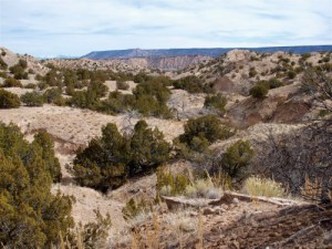
Ahhh-CHOO! &F*XB$ Junipers!
If you visit New Mexico in February or March, you are sure to hear residents complaining bitterly about allergies. In fact, late Winter is often called “juniper season” because that’s the primary time when our junipers are shedding their pollen. Several other species also inhabit the state, but the majority of junipers in the Santa Fe area are One-Seed Junipers (Juniperus monosperma).
Despite the suffering their pollen inflicts, junipers are supremely adapted to the Southwest and are an essential component of the ecosystem. Adaptations to dry conditions include their small, wax-covered, scale-like needles which reduce evaporation; the ability to suspend growth during periods of drought; and cell peculiarities within the tree’s circulatory system which resist the plant equivalent of vapor lock during low water. In fact, when Santa Fe had it’s latest drought in 2000-2004, in rangeland areas it was overwhelmingly the junipers which survived.
If you visit New Mexico in February or March, you are sure to hear residents complaining bitterly about allergies. In fact, late Winter is often called “juniper season” because that’s the primary time when our junipers are shedding their pollen. Several other species also inhabit the state, but the majority of junipers in the Santa Fe area are One-Seed Junipers (Juniperus monosperma).
Despite the suffering their pollen inflicts, junipers are supremely adapted to the Southwest and are an essential component of the ecosystem. Adaptations to dry conditions include their small, wax-covered, scale-like needles which reduce evaporation; the ability to suspend growth during periods of drought; and cell peculiarities within the tree’s circulatory system which resist the plant equivalent of vapor lock during low water. In fact, when Santa Fe had it’s latest drought in 2000-2004, in rangeland areas it was overwhelmingly the junipers which survived.

Although a conifer like pines and firs, the cones of the One-Seed Juniper are very different. Male trees bear clusters of tiny, bronze, bud-like cones at the tips of branches. When pollen is ripe in February, any bump of the branch yields a cloud of yellow pollen which wafts on the breeze. Female trees have a “cone” which matures into a sweet, blue , pea-sized berry, often thousands per tree, which ripens at the first frost–usually in October.
These berries provide a very welcome and essential food supply to many birds and animals at a time of year when other sources are declining. Local Mountain Bluebirds (Sialia currucoides) have been studied and their winter diet is more than 90% juniper berries. Coyotes feast on the berries, too, and early wintertime scat is almost solid with juniper seeds.
But turnabout is fair play, and the junipers benefit from the animals, too. By having attractive berries around them, the seeds are transported away from parent trees to sprout elsewhere. Over 60 million acres in the Southwest is inhabited by One-Seed Junipers, and that number is increasing as rangeland has been grazed and protected from regularly-occurring fires.
These berries provide a very welcome and essential food supply to many birds and animals at a time of year when other sources are declining. Local Mountain Bluebirds (Sialia currucoides) have been studied and their winter diet is more than 90% juniper berries. Coyotes feast on the berries, too, and early wintertime scat is almost solid with juniper seeds.
But turnabout is fair play, and the junipers benefit from the animals, too. By having attractive berries around them, the seeds are transported away from parent trees to sprout elsewhere. Over 60 million acres in the Southwest is inhabited by One-Seed Junipers, and that number is increasing as rangeland has been grazed and protected from regularly-occurring fires.

 RSS Feed
RSS Feed
